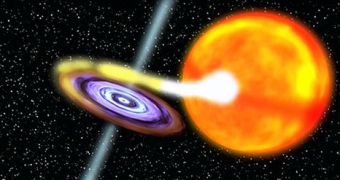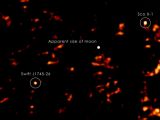NASA's Swift satellite has discovered tell-tale signs of a stellar-mass black hole relatively close to the center of our galaxy. The satellite detected a big surge in activity in the high-energy X-ray spectrum in a region of the sky close the center of the Milky Way.
This surge was determined to be the signs of a rare X-ray novae which indicates that there is a black hole nearby.
X-ray novae are a source of high-energy X-ray that bursts to life and peaks over a few days then slowly dying down in intensity over the next few months.
"Bright X-ray novae are so rare that they're essentially once-a-mission events and this is the first one Swift has seen," Neil Gehrels, the Swift mission principal investigator, at NASA's Goddard Space Flight Center, said.
"This is really something we've been waiting for," he added.
This particular X-ray nova, lovingly named Swift J1745-26, reached energies over 10 keV on September 18, at its peak. Since then, the energy spectrum has been moving towards lower energy, or softer X-rays.
It's much less powerful in the high-energy range, but is now 30 times brighter in soft X-rays than it was when it was created.
It is believed to be somewhere around 20,000 to 30,000 light years from the center of the galaxy, though there ahve been no precise measurements at this point.
X-ray novae, unlike regular novae, aren't the result of a dying star, but rather form when a pocket of gas is accelerated towards a high-gravity object, a neutron star or a black hole. In this case, the scientists believe the object to be a stellar-mass black hole.
"The pattern we're seeing is observed in X-ray novae where the central object is a black hole. Once the X-rays fade away, we hope to measure its mass and confirm its black hole status," Boris Sbarufatti, an astrophysicist at Brera Observatory in Milan, Italy, said.
This type of black hole is typically found in a binary system along with a regular star. The black hole steals gas from the star. Commonly, gas is funneled from the star into the black hole in a steady stream.
In some cases though, the gas accumulates in the black hole's accretion disk but doesn't actually fall towards the object.
When a certain threshold is reached, a large amount of gas suddenly starts "falling" towards the black hole, heats up and starts emitting radiation in the X-Ray spectrum. This only lasts for a short while, until the accumulated gas is consumed. The phenomenon repeats itself every few decades.
While it is believed that there are numerous stellar-mass black holes in our galaxy, on the order of 100 million, only a dozen or two have been observed.

 14 DAY TRIAL //
14 DAY TRIAL // 
